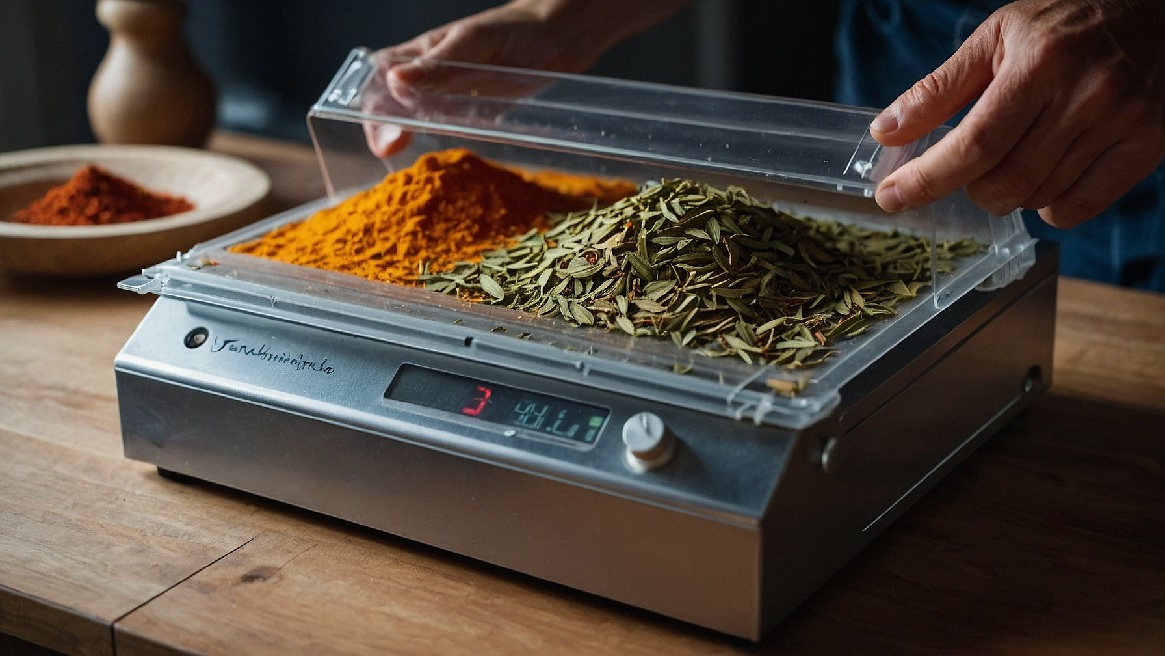Table of Contents
Using a dehydrator for making spices is straightforward and rewarding. It involves drying herbs or vegetables until all moisture is removed, then grinding them into powder.
Dehydrators are excellent tools for preserving flavors. Fresh herbs and vegetables can be dried and stored for later use. This method helps retain the natural taste and nutrients. Making your own spices at home is not only economical but also ensures quality.
Dehydrating is a simple process that anyone can master with a little patience. In this guide, we’ll walk you through the steps, from choosing the right ingredients to storing your homemade spices. Whether you’re a novice or an experienced cook, you’ll find this process both fun and satisfying. Ready to get started? Let’s dive in!
Choosing The Right Dehydrator

Using a dehydrator for making spices can be a great way to preserve flavor and extend the shelf life of your herbs. Choosing the right dehydrator is key to the dehydration process. A good dehydrator will remove moisture effectively, ensuring that your spices are dry and ready for culinary uses. This guide will help you understand the different types of dehydrators and the key features to look for when selecting one for home cooking.
Types Of Dehydrators
There are several types of dehydrators available on the market. Each type has its own advantages and is suitable for different needs.
- Stackable Dehydrators: These are compact and easy to store. They consist of multiple trays stacked on top of each other. They are ideal for small batches of spice drying.
- Box and Shelf Dehydrators: These have a box-like structure with shelves inside. They offer more space and are great for larger batches. They provide uniform drying as air circulates evenly.
- Commercial Dehydrators: These are larger and more powerful. They are designed for heavy-duty use and can handle large quantities of herbs drying. They are perfect for those who make spice blends regularly.
Choosing the right type depends on your needs and kitchen space. Stackable dehydrators are perfect for small kitchens. Box and shelf dehydrators are ideal for larger batches. Commercial dehydrators are best for frequent and large-scale spice drying.
Also Read: Jimmy Dean Breakfast Sausage Seasoning Recipe
Key Features To Look For

When selecting a dehydrator, several key features should be considered. These features will ensure efficient and effective moisture removal.
- Temperature Control: Look for a dehydrator with adjustable temperature settings. Different spices require different drying temperatures. This feature allows precise control over the dehydration process.
- Timer: A built-in timer is very useful. It helps in setting the drying time accurately. You can leave your spices to dry without worrying about over-drying.
- Airflow System: An efficient airflow system ensures uniform drying. It prevents uneven moisture removal, which can affect the quality of your spices.
- Capacity: Consider the capacity of the dehydrator. Choose one that fits your batch size needs. Larger capacity models are better for making spice blends in bulk.
- Ease of Cleaning: Look for a dehydrator that is easy to clean. Removable trays and parts make cleaning simple and quick.
By focusing on these key features, you can select a dehydrator that suits your home cooking needs. Temperature control and timer are crucial for precision. An efficient airflow system and adequate capacity ensure high-quality dried spices. Ease of cleaning adds convenience to your kitchen appliance.
Preparing Your Spices
Using a dehydrator to make your own spices is a rewarding experience. It allows you to create fresh, flavorful spices at home. Preparing your spices correctly is the key to success. This process involves selecting fresh ingredients and using proper cleaning and cutting techniques. Let’s dive into the details of each step.
Selecting Fresh Ingredients
Choosing the right ingredients is essential for making high-quality spices. Fresh ingredients have more flavor and nutrients. Here are some tips for selecting the best ingredients:
- Freshness: Always use fresh herbs and vegetables. They should be free from blemishes.
- Organic: Opt for organic ingredients when possible. They have fewer chemicals.
- Color: Look for vibrant colors. Dull colors may indicate old ingredients.
Visiting local farmers’ markets can be a great way to find fresh produce. You can also grow your own herbs and vegetables at home. Home-grown ingredients are often fresher and more flavorful.
To summarize:
| Factor | Importance |
|---|---|
| Freshness | Ensures maximum flavor and nutrients |
| Organic | Reduces chemical intake |
| Color | Indicates freshness and quality |
Cleaning And Cutting Techniques
Proper cleaning and cutting are crucial steps in preparing your spices. Clean ingredients ensure the removal of dirt and bacteria. Here are some steps to follow:
- Rinse: Rinse herbs and vegetables under cold water.
- Dry: Pat them dry with a clean towel. Excess moisture can affect drying.
- Trim: Remove any damaged or wilted parts.
After cleaning, cutting the ingredients properly is the next step. Cutting them into uniform pieces ensures even drying. Here are some tips:
- Size: Cut herbs into small pieces. This helps them dry faster.
- Uniformity: Ensure pieces are of similar size. This ensures even drying.
- Thin Slices: For vegetables, slice them thinly. Thicker slices take longer to dry.
Using a sharp knife or kitchen scissors can make the cutting process easier. Always work on a clean cutting board to maintain hygiene.
Dehydration Process

Introduction paragraph about How Do I Use a Dehydrator for Making Spices? and Dehydration Process…
Using a dehydrator to make spices at home is a fantastic way to enhance your culinary creations. The dehydration process helps in preserving herbs and dehydrating vegetables efficiently. This method ensures that your homemade spice blends retain their flavors for longer periods. By understanding the correct temperature settings and timing guidelines, you can achieve the best results in spice drying techniques. With these tips, you’ll be able to create flavorful and aromatic spices that can elevate any dish.
Temperature Settings
The temperature settings on your food dehydrator play a crucial role in the dehydration process. For preserving herbs, the ideal temperature range is between 95°F and 115°F. This ensures that the herbs retain their essential oils and flavors. When dehydrating vegetables, you should set the temperature to 125°F to 135°F. This helps in removing moisture efficiently without cooking the vegetables.
Here are some general guidelines for food dehydrator settings:
- Herbs and delicate greens: 95°F to 115°F
- Vegetables: 125°F to 135°F
- Fruits: 135°F to 145°F
- Meats (for jerky): 145°F to 155°F
It’s essential to monitor the temperature regularly. Consistent temperature helps in achieving the desired dryness without compromising the flavor enhancement of your spices. Adjusting the settings as needed ensures optimal results for homemade spice blends.
Timing Guidelines
Timing is key when using a dehydrator for making spices. Different types of culinary herbs and vegetables require specific drying times for herbs to ensure they are properly dehydrated. Here are some general guidelines:
| Herb/Vegetable | Drying Time |
|---|---|
| Mint | 4-6 hours |
| Basil | 6-8 hours |
| Tomatoes | 8-10 hours |
| Peppers | 10-12 hours |
It’s important to check the dryness periodically during the dehydration process. Herbs should be crisp and crumble easily, while vegetables should be firm and break without bending. These guidelines ensure the proper shelf life of spices, maintaining their potency and flavor.
Remember, drying times can vary based on factors like humidity and thickness of the herbs or vegetables. Always start checking a bit earlier than the suggested time. Adjust as necessary for the best results.
Storing Dehydrated Spices
Dehydrating spices is a great way to preserve their flavor and extend their shelf life. A food dehydrator makes this process simple and efficient. The key to storing dehydrated spices is to keep them fresh and flavorful. This involves using the right storage containers and following proper usage tips.
Best Storage Containers
Choosing the right storage containers is important for preserving flavor and maintaining the quality of your spices. Here are some options:
- Glass Jars: These are airtight and do not absorb odors. They are perfect for long-term storage.
- Plastic Containers: Ensure they are food-grade and BPA-free. They are lightweight and easy to handle.
- Metal Tins: These are durable and block light, which helps in preserving flavor.
- Vacuum Sealed Bags: They remove air and prevent moisture. Ideal for long-term storage.
Store your spices in a cool, dry place. Avoid direct sunlight and heat sources. Label each container with the spice name and date of dehydration. This helps in managing your spice shelf life.
Shelf Life And Usage Tips
Dehydrated spices have a longer shelf life than fresh ones. Here are some tips for extending their shelf life:
- Keep them Dry: Moisture reduces the shelf life of spices. Always use dry spoons when handling them.
- Store in Small Batches: This helps in keeping the majority of your spices fresh.
- Check for Freshness: If the spice loses its aroma, it is time to replace it.
Using dehydrated spices is simple. Grind them before using to enhance their flavor. Add them to your favorite recipes for a flavor boost. Homemade spice blends can be made by mixing different dried herbs and spices. Experiment with different combinations to create unique flavors. Dehydrated spice recipes can add a new dimension to your cooking. Keep experimenting and enjoy the process of spice preservation.
Frequently Asked Questions
Can You Use A Dehydrator To Make Your Own Spices?
Yes, you can use a dehydrator to make your own spices. Dry herbs, seeds, and vegetables thoroughly. Grind them into fine powders for homemade spices.
Is It Better To Air Dry Herbs Or Use A Dehydrator?
Using a dehydrator is faster and more efficient for drying herbs. Air drying is cost-effective and preserves flavor. Choose based on your needs.
How Long Does It Take To Dehydrate Spices?
Dehydrating spices typically takes 2 to 6 hours. The time varies depending on the spice and dehydration method.
How Long Do Dehydrated Spices Last?
Dehydrated spices generally last 1-2 years if stored properly. Keep them in a cool, dark place. Ensure containers are airtight.
Conclusion
Using a dehydrator for making spices is easy and rewarding. You can enjoy fresh, homemade spices anytime. Just follow the simple steps mentioned. The flavors will be richer and more aromatic. Plus, you save money and avoid preservatives. Experiment with different herbs and spices.
Your cooking will never be the same. Give it a try and experience the difference. Happy dehydrating and spicing up your meals!


